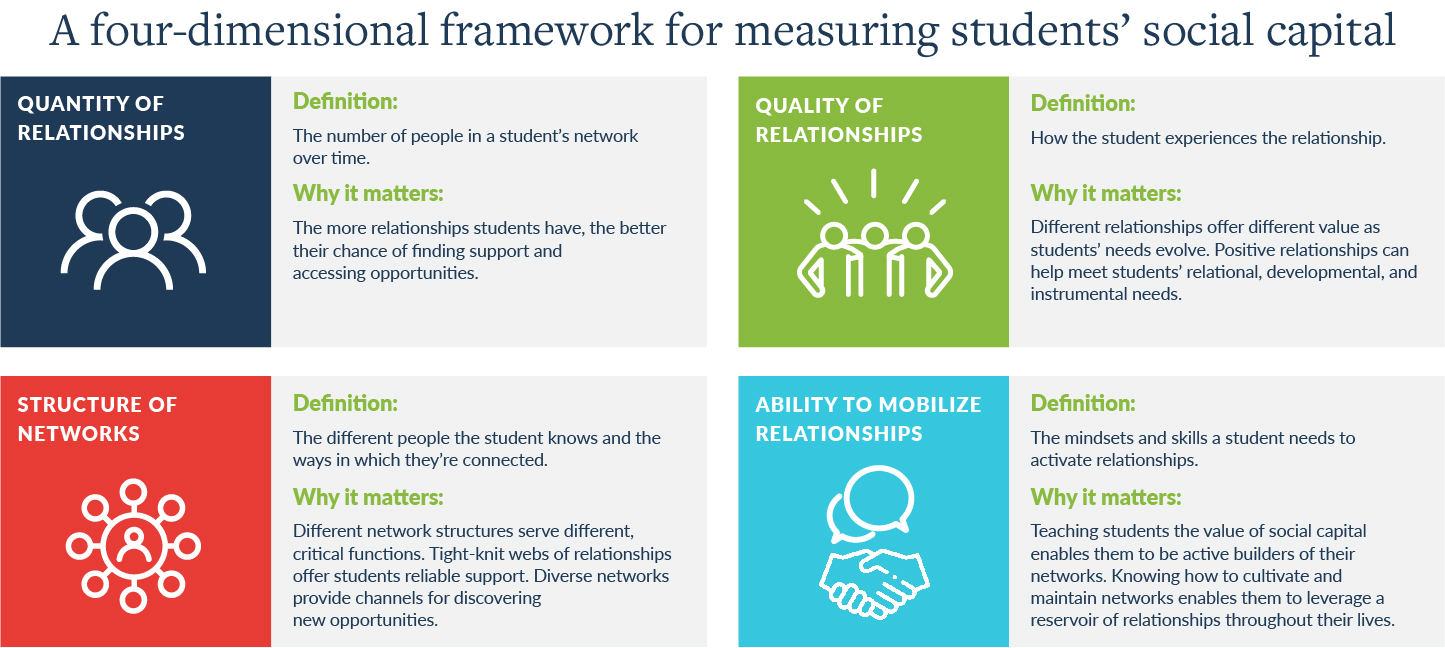It’s become common knowledge that students who’ve returned to in-person school this year in the wake of the pandemic are not only experiencing potential setbacks in their learning progress, but also severe mental health challenges. Students most affected by these challenges continue to be those from under-resourced communities and homes across a range of needs from healthcare to basic WiFi access.
To fuel student success equitably, particularly in the upcoming year, schools and postsecondary institutions must address students’ unequal access to resources that drive academic and economic success—and these resources must go beyond what schools traditionally prioritize access to if they hope to help students emerge from an unprecedented crisis.
One critical, too-often untapped resource is students’ networks. Depending on their background, students report vastly different webs of relationships at their disposal. Despite their indisputable value in the student success equation and broad agreement in the education field that “relationships matter,” there’s scarce attention paid to the measurement of students’ relationships and the value of the networks they form over time.
We can’t improve what we don’t measure
All too often, schools and institutions leave students’ access to networks to chance. In the absence of measurement, relationship assets may go undetected and gaps undiagnosed. By intentionally measuring students’ social capital—access to and ability to mobilize connections that can help them further their potential and goals—education systems stand to not only help solve some of the most stubborn pandemic-heightened problems, but fuel students toward economic mobility.
In my and my colleague Julia Freeland Fisher’s paper, “The Missing Metrics,” we propose a four-dimensional framework for measuring students’ social capital, based on empirical research as well as practices modeled by early innovators across K–12, postsecondary, and workforce development.
Three of the dimensions serve as a lens to measure students’ access to relationships: the quantity of relationships in students’ networks, the quality of relationships in students’ networks, and the structure of students’ networks. The fourth dimension serves as a lens to measure the mindsets and skills students need to activate relationships: students’ ability to mobilize networks. The framework is meant to help schools and systems start to gather information and measure their efforts to equitably build students’ relationships and networks as gateways to opportunity.

Examples from schools and institutions
Over the last few years, a host of early innovators have started to build an evidence base for the instrumental role that students’ relationships—alongside individual effort and ability—play in the student success equation. Because relationships are complex, these programs measure across multiple dimensions to better understand the depth and breadth of relationships between students and staff and also to ensure students expand their networks in the course of their learning.
For example, ASU Local, a hybrid online learning and work-based learning degree program, offers students high-touch support with both academic and career coaches. Students are asked to rate their student-coach relationship quality through statements such as, “I feel supported by…the coaches” and “I feel like the…coaches have created a comfortable and safe environment” to ensure that the coaches are meeting students’ relational, developmental, and instrumental needs—three indicators of high-quality relationships. Students’ mindsets and ability to cultivate social capital are also tracked through student responses to statements such as, “I am confident in work environments” and “I consider my new connections members of my professional network.”
Technology is also leveraged by some innovators to diversify and expand students’ professional networks. For instance, Big Picture Learning, a nonprofit that supports a network of high schools that offer internship-based learning, uses a technology tool called ImBlaze to pose questions to students and their internship site mentors on a daily or weekly basis. Some partner schools use the app to ask mentors about the extent to which they open up their networks to the students they work with. One school asks mentors, “Did you introduce your young person to someone in your professional network today?” Others ask similar questions to students such as, “Did your mentor connect you with someone in their professional network today?” to ensure student responses are aligned with the adults and that students have awareness and agency in maintaining these relationships over time.
Building students’ networks through practical measurement
In the long run, better data and measurement can drive better design. Kate Schrauth, executive director of iCouldBe, a virtual mentoring program connecting high school students to online mentors, cautions, “Without the data—and the tools to collect and analyze the data—how can we measure the impact of expanded networks for our students?”
The innovative programs we point to in “The Missing Metrics” report harness the power of practical measurement to capture data and learn which relationships are working for young people, and iterate on curriculum and student experiences to ensure all are equitably connected. With the right tools and investments, more schools and programs can follow suit.
Schools and institutions ready to prioritize students’ social capital will benefit from incorporating measurement early on to first identify relationships students already have within reach. From there, practical measures can drive program improvement by informing data-driven, personalized strategies for increasing student access to relationships and networks that will open doors to economic mobility.
Although nascent, early efforts by pioneering schools and education programs show evidence of closing the opportunity gap for youth and adults alike by measuring along multiple dimensions. By investing in and measuring the social resources at students’ disposal, schools can start to produce breakthrough K–12 and postsecondary outcomes for all students, not just some.


